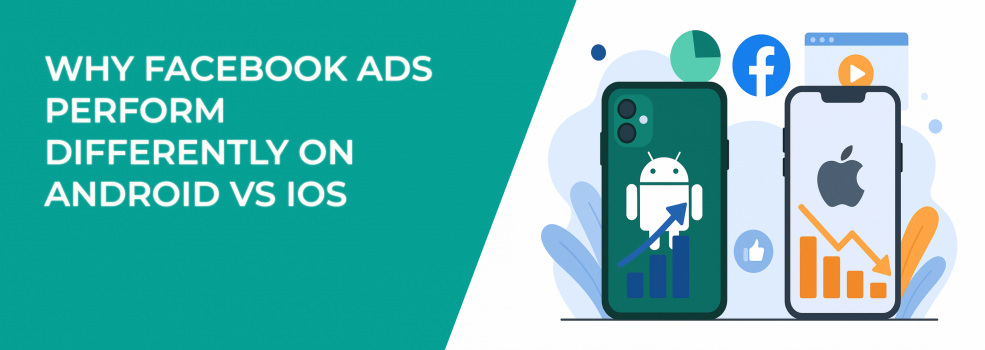If you’ve been running Facebook or Instagram ads for a while, you’ve probably noticed a strange pattern in your performance reports. Android and iOS users don’t behave the same — and your Facebook ad campaigns reflect that. Different click-through rates. Different conversions. Different costs.
But why does this happen?
The gap in performance between Android and iOS devices goes deeper than just hardware preferences. It’s driven by a mix of:
-
Data privacy restrictions,
-
User behavior differences,
-
Platform ecosystems,
-
And how each operating system interacts with Facebook Ads.
Let’s break it all down and look at how advertisers can adjust their strategy to make Facebook ads more effective on both platforms.
The Data Divide: Why iOS Users Are Harder to Track
When Apple introduced its App Tracking Transparency (ATT) framework in 2021, it changed everything for advertisers. Facebook (Meta) lost access to critical data from iOS users, making it harder to track behavior and attribute conversions.
Here’s what happens on iOS:
-
Most users opt out of tracking;
-
Facebook can’t reliably measure post-click behavior;
-
Conversion events often go unattributed or underreported.
This severely limits the Meta ad algorithm’s ability to optimize for performance. You’re essentially feeding it less data and getting weaker results.
Conversion visibility varies sharply by platform, which means you need to test both to learn what works best for you.
On Android, things look very different:
-
App tracking is generally still allowed;
-
Attribution windows remain flexible;
-
Advertisers get more event-level data;
-
ROAS reports are more reliable and complete.
It’s like navigating with a GPS on Android vs using a paper map on iOS. If your Facebook Ads report stronger results from Android users, it may simply be because you're seeing more of what’s actually happening.
Tip: use Meta’s Conversion API (CAPI) alongside the Meta Pixel. It helps restore lost tracking data, especially for iOS devices, and improves Facebook's optimization process.
If you're struggling with performance drops after iOS updates, explore our guide on combating iOS privacy changes with smart targeting strategies.
Device Culture: How Android vs. iOS Users Behave
The Android vs iPhone split isn’t just technical. It's also behavioral. And those behavioral differences show up in your ad metrics.
iOS users tend to:
-
Have higher average incomes.
-
Spend more money in paid apps and subscriptions.
-
Prefer privacy and opt out of ad tracking more often.
-
Use premium, closed ecosystems (like Safari or Apple Mail).
-
Interact less with lower-funnel ads like direct offers.
Android users tend to:
-
Represent a broader global and economic demographic.
-
Be more likely to click on ads, especially in mobile web.
-
Use a wider mix of apps and devices.
-
Engage more with cost-conscious offers and freemium models.
-
Be less restrictive with tracking permissions.
What's interesting, Android holds roughly 72% of the global mobile market. But in the U.S., iOS dominates with over 58%, especially among younger, higher-income consumers.
Example: you launch a campaign for a language learning app. On Android, you get high install rates due to affordability and global reach. On iOS, install volume is lower but retention and in-app purchase rates are higher. Without LTV analysis, it’s easy to misinterpret the true value of each audience.
To build stronger campaigns based on user behavior, check out our step-by-step framework on how to define a target audience for marketing.
Platform Ecosystem and Fragmentation
Android is open-source and highly fragmented. This leads to more device types, app stores, screen sizes, and OS versions. While it makes testing more complicated, it also allows advertisers to gather richer and more varied data.
iOS, by contrast, is a closed system. It features:
-
Uniform updates across devices;
-
Stricter App Store policies;
-
Stronger built-in privacy controls.
This consistency benefits users, but limits what advertisers can track and optimize. Facebook’s ad delivery system thrives on data signals, and there are simply more available on Android.
Tip: run separate campaigns for Android and iOS. This lets you tailor creatives, targeting, and bidding strategies to the strengths and limitations of each platform.
Costs and Conversion Rates: Not Always What They Seem
Here’s where it gets more complicated. You may notice higher CPMs (cost per 1,000 impressions) on iOS. That often leads advertisers to assume iOS traffic is higher quality.
Sometimes that’s true. Sometimes it isn’t.
Because Facebook can’t accurately track many iOS conversions, your campaign might be undervaluing iPhone users — even when they’re converting.
Meanwhile, Android traffic often looks more efficient:
-
Lower CPMs.
-
Higher reported conversions.
-
Better algorithm learning due to stronger signals.
But again, visibility doesn’t equal value.
Tip: evaluate Customer Lifetime Value (LTV) separately for Android and iOS. Use CRM integrations, offline events, or cohort reports to see who’s actually generating revenue long term.
Also, data shows that iOS users generated over $150 billion in App Store revenue — nearly double that of the Google Play Store. So don’t ignore iOS just because the dashboard says it's underperforming.
What Should Facebook Advertisers Do?
To manage the growing gap between Android and iOS performance, Facebook advertisers need a platform-specific approach. Treating both ecosystems as a single audience pool will dilute your insights, waste ad spend, and hide optimization opportunities.
Here’s what you should be doing right now:
1. Segment by operating system
Analyze performance separately for Android and iOS.
Don’t rely on blended averages — they mask what’s really working (or not working). Running combined campaigns might make reporting easier, but it also creates misleading ROAS data, weakens optimization, and forces the Meta algorithm to make trade-offs across two fundamentally different platforms.
2. Use server-side tracking
Set up Meta’s Conversion API (CAPI) in parallel with your pixel.
This is especially critical for iOS users who opt out of tracking. CAPI lets you send events directly from your server, improving data accuracy and helping Meta’s algorithm make smarter delivery decisions. It’s not a full replacement for client-side tracking, but it closes major gaps — especially in post-click conversions and purchases.
3. Build and use first-party data
Start collecting emails, phone numbers, and behavior data within your own properties.
Relying on Facebook’s pixel alone is no longer enough — especially on iOS. Create experiences that encourage users to log in, register, or sign up for something valuable. Then use that data to build Custom Audiences, seed Lookalikes, or trigger personalized retargeting workflows.
4. Test different attribution windows
Compare performance across multiple attribution settings.
Many conversions now fall outside the default 1-day view or 7-day click windows — particularly on iOS. By testing 1-day vs 7-day models (and possibly 28-day where available via CAPI), you’ll uncover delayed conversions and get a more realistic view of your true cost per acquisition.
5. Cross-validate your results
Don’t rely solely on Facebook’s Ads Manager for insights.
Supplement your analysis with tools like Google Analytics 4 (GA4), Shopify order reports, offline conversions, and post-purchase surveys. If Facebook says iOS isn’t performing, but your CRM shows repeat purchases and long-term engagement — that’s your truth. Not the dashboard.
Facebook ads can still perform well on both platforms. But Android and iOS need different strategies, so treat them as separate channels, and you’ll waste less budget and get better outcomes.
Final Thoughts
The performance gap between iOS and Android on Facebook Ads isn’t going away. If anything, it's getting more pronounced.
As privacy regulations tighten and tracking shrinks, advertisers must stop treating iOS and Android as interchangeable. Instead:
-
Treat them as two different ecosystems,
-
Customize your ad strategies,
-
Adjust your expectations,
-
Question the data you’re seeing.
Because what Facebook doesn’t track could be what matters most. Ask yourself:
-
Which platform gives me better LTV, not just better CTR?
-
What behavior is going untracked, and how can I surface it?
-
Am I optimizing based on what I can see or what really drives growth?
In the world of Facebook and Instagram advertising, visibility is power. And smarter segmentation between iOS and Android could be the edge your campaigns need.

